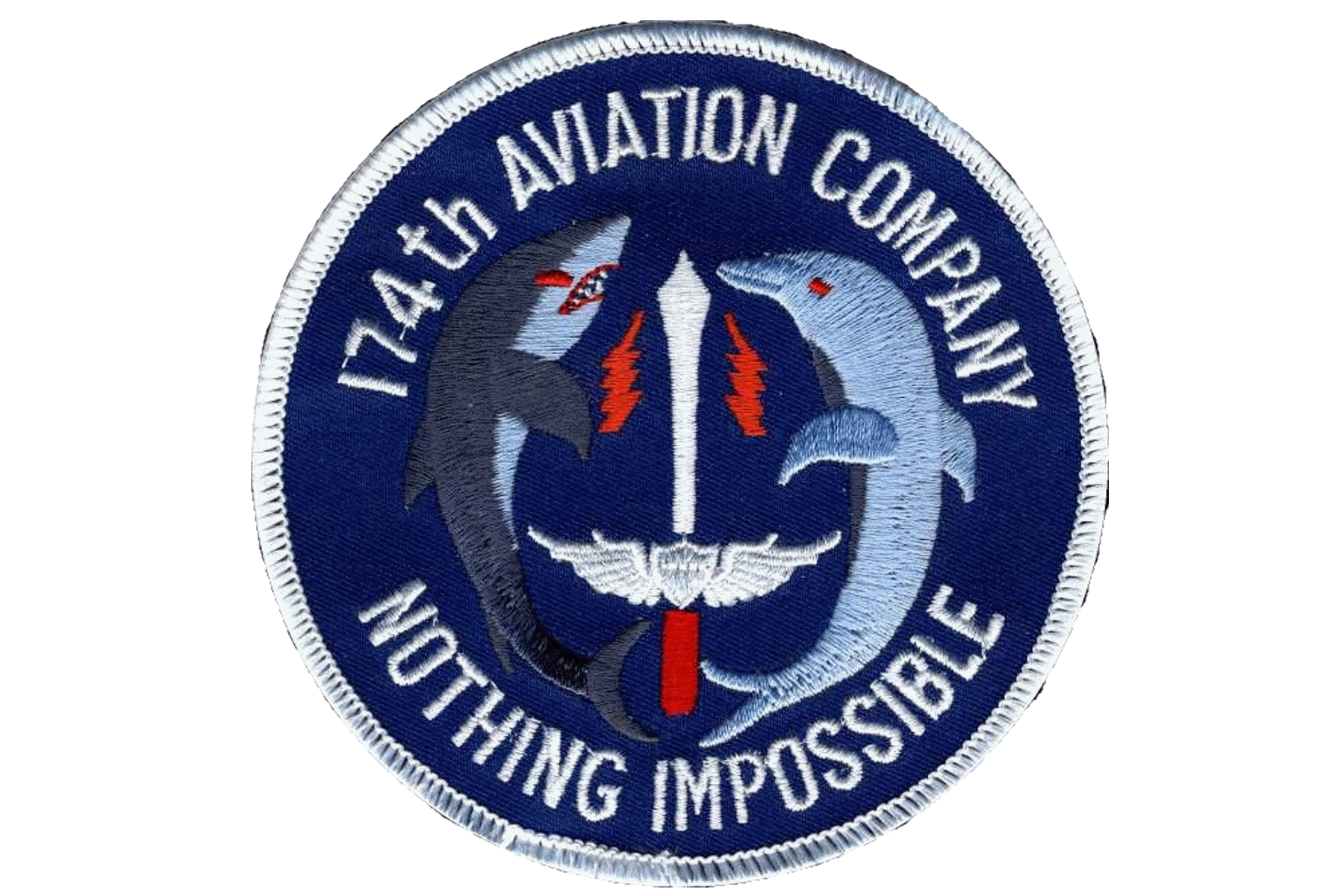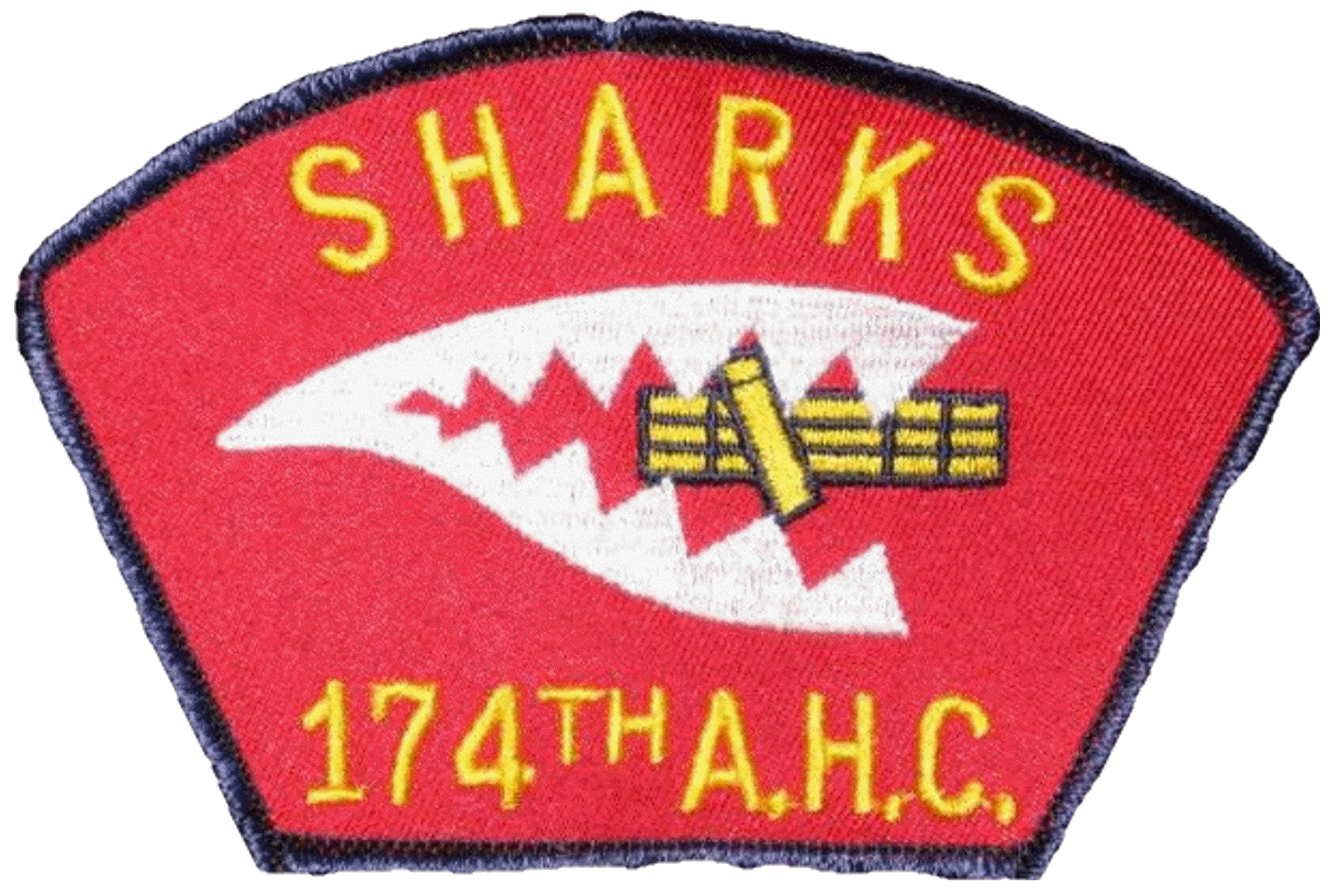174th Assault
Helicopter Company
DOLPHINS & SHARKS
 Click here
Click here  to write us at the website
to write us at the website 
Medevac Rescue of the "Surfer's" Crew
|
The 174 AHC lost UH-1C #66-15161 in Laos at coordinates XD583284 on February 21, 1971. This was
the Shark know as "SURFER." 174th Shark pilot Gary Harter remembers this with special
clarity:
"Charlie models had two well known problems that were magnified during Lam
Son 719. Because of the high DA (density altitude) we could only carry about 45 minutes worth
of fuel if we were fully loaded with ordnance, and we flew slower than the Hotels
(UH-1H slicks) and Snakes (AH-1G Cobras). While the majority of our missions were to cover
our own lift ships, we also often provided short-notice escort for DUSTOFF (medical evacuation)
missions.
Most everyone talks about refueling at Khe Sanh, but Charlie-models habitually grabbed fuel at
Lang Vei. It was just over the border back in Vietnam, and often we couldn't make it back to
Khe Sanh.
On this day, Fred Thompson and I were flying together in Shark UH-1C #65-09470 'Charlie Tuna'
(named and artwork on the quarter panel done by C/E Bill Wilder)
as 'wing' for CPT Souder and WO1 Bruce Marshall in the 'lead' Shark gunship. All Shark gunships
were painted with a wide set of teeth that started just aft of the pilot doors.
I guess you could say that our CEs (crew chiefs) took nose art to the max!
Each ship had a name; Souder and Marshall were flying 'Surfer' that day. [*Assistant Webmaster note: SP4 Wilder
would have prefered to call #470 "Sorry Charlie". Bill says, "It was an Albatros. It was underpowered
and drank fuel."- Bill.]
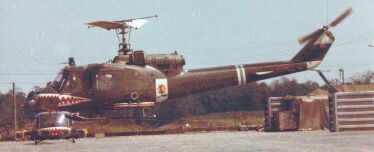
Shark 161, "SURFER," hovers out of the bunker at Khe Sanh past another Shark on one of her last missions before being shot down in Laos. Note the personalized artwork on the "quarter panel" behind the rocket pods, just in front of the tail boom. Photo by Fred Thompson, 1971. |
We launched to provide escort for a single DUSTOFF ship that I later learned was flown by Howard 'Mo' Modjeski. His mission was to go deep into Base Area 604 to get some ARVN wounded. He lead out because he knew exactly where we were going; then Souder and Bruce, and finally our ship. We had just passed over a ridge south and east of FSBs BRICK and DON when we watched in amazement as the lead UH-1C took at least ten, maybe fifteen hits. Bruce called out that they were taking fire from 3 o'clock, 6 o'clock, and 9 o'clock. We could easily see the big flashes hit the ship and pieces flying off. Souder radioed that Bruce was wounded and that they were going down.
They made a forced landing in a grassy area adjacent to QL92, a narrow north-south road that departed QL9 just west of A LUOI. I alerted 'Mo,' who seemed to be flying away! We made several firing passes and orbits around the downed ship before we decided to land near them.
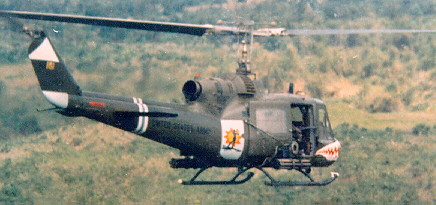
The Surfer headed for Laos. (Photo by Fred Thompson, 1971) |
I distinctly remember seeing a rusted truck on one side of the road and lots
of spider holes along the road. Just before I landed in a bomb crater, we
blew the rocket pods (with the explosive bolts where they attached to the aircraft),
because I knew we'd have a devil of a time getting out of that confined area. Fred and
Bill Wilder, our CE, jumped out and started running toward the downed ship. I was on
the radio calling for 'Mo.' He turned around and used FM homing to get back to us.
Fred and Bill came back in a few minutes, the vegetation was just too thick for them to get to the other ship. We staggered out of that bomb crater and the most beautiful sight of all greeted us about a quarter mile ahead--the DUSTOFF ship! In
no time, they are over the downed Shark. We must have looked ridiculous to
the NVA, no rocket pods and our mini-guns just hanging on the sides by their
ammo chutes! [*Assistant Webmaster note: Wilder states, "I pulled every pin release on the
aircraft. The pilots doors- we left behind on the ground and the armament subsystems were left hanging by wires/cords below
our skids. Ridiculous looking? Yes it sure was."-Bill.]
Fred and I were and still are best friends but we'd argue like mad with each other when we flew
together. Maybe that kept us sharp and alive, I don't know. Anyway, that day Fred's TAKING
PICTURES of the DUSTOFF over the downed Shark! The DUSTOFF guys picked up everyone.
Bruce had been hit in both legs. His wounds were very serious and he was evacuated back to
the States. As we departed the area, I told the DUSTOFF that I was returning low level--I was
just tired of being a target. He said 'See Ďya'' and climbed for altitude.
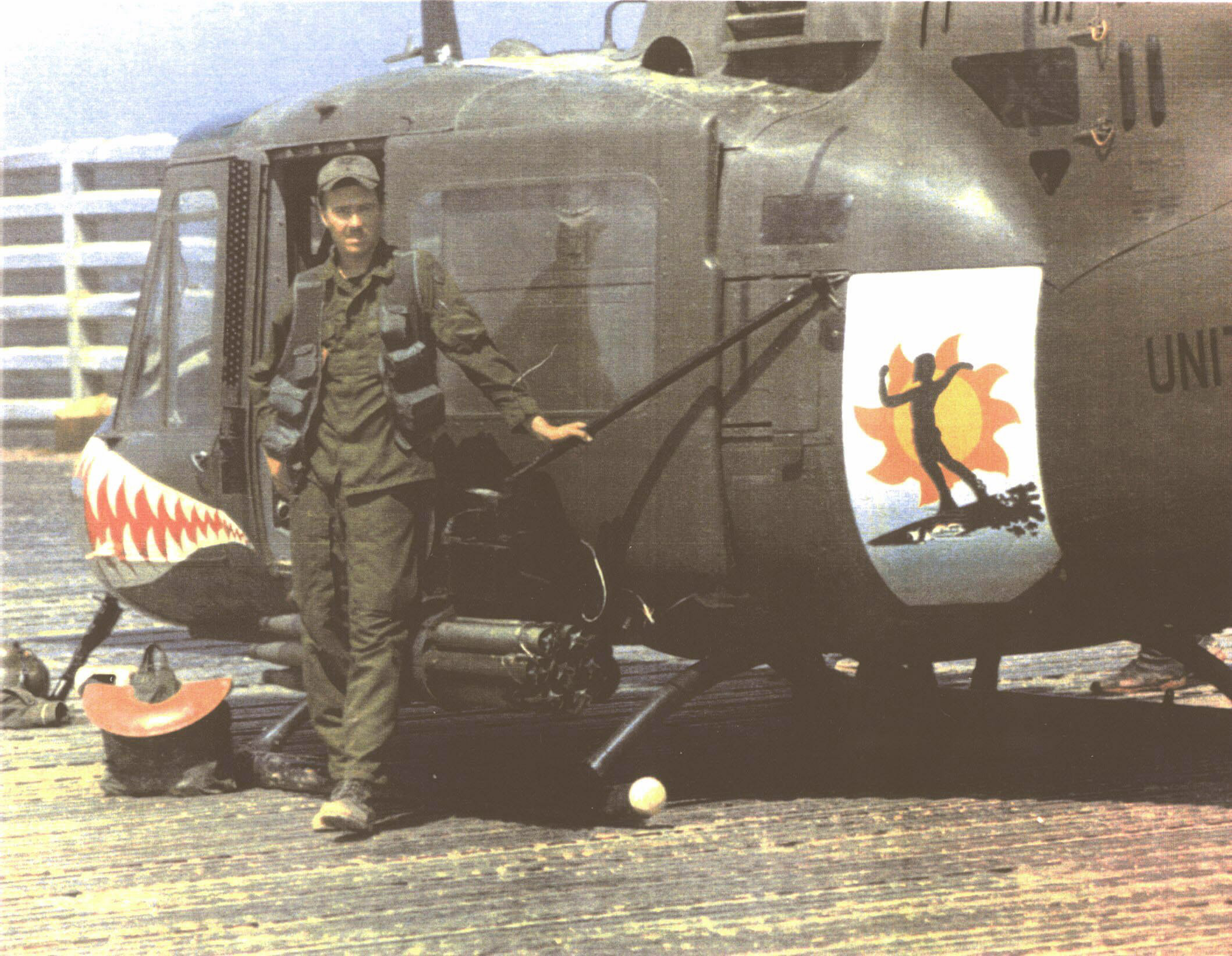
A young W01 Fred Thompson with Shark 161, "Surfer," a few days before the shoot-down in Laos. Note the personalized artwork, a surfer riding the back of a shark, with a bright red and yellow sun in the background. Note Fred's webbed survival vest, Fred's flight bag and his 'special' seat cushion, and the artwork of the "Surfer"(done by SP4 Budd Vann). Photo property of Fred Thompson, 1971. |
During the next day or so there was some discussion about trying to recover 'Surfer.' It
was my opinion that it wasn't worth risking anyone to recover it because the battle damage
had been extensive and, for sure, the NVA had been able to get to the aircraft. About
two days later they put an Arch Light (B-52 bomb strike) through that section which destroyed
the aircraft."- Gary Harter
Howard "Mo" Modjeski remembers the mission this way:
"Operations gave us the frequency and call sign of the Charlie-model gunships
assigned to the mission, but I had no idea who it was until we made initial
contact. You have to understand Fred Thompson was the original Southern
California Surfer snatched off a surf board and thrown into flight school at
a very tender age. He still talked like he was on the beach, even in the
middle of a war. To this day he still says, 'Bitchin!' I recognized Fred's voice upon initial contact. I remember asking if it was Fred, he confirmed and I told him I was Mo. Bruce came on the air and we had a great little flight school reunion.
I was blessed to fly most, if not all, of my time on Lam Son 719 with the crew of Mike Basler as Crew Chief and Jeff Morris as Medic, on
the 'Iron Butterfly.' I have forgotten the aircraft serial number. I am embarrassed to admit I cannot remember who our copilot was on this mission. Dave Borrell flew with us most of the time in Laos, but I know he was still flying with a 571st AC (aircraft commander) the night before. We probably still had a 571st copilot with us on this date but I do not remember his name. Jeff Morris is one of the most gifted and dedicated Medics I ever had the privilege to fly with. I've seen Morris pick up a half dozen patients in the middle of the night, and in a ten minute ride back to an aid station, dress wounds on every patient, start three IV's in the dark in the back of a bouncing helicopter and give artificial respiration to one of the patients. If Morris did not become a doctor, society missed out on a real talent.
Some may recognize the name Basler. Mike Basler's father founded a company called Basler Airlines of Oshkosh, Wisc. The company rebuilds DC-3s and converts them to turboprop power. Mike Basler must have learned quite a bit from his father,
because the 'Iron Butterfly' was the oldest and seemingly weakest bird in the
498th. It always took four or five extra pounds of torque to hover or cruise
compared to other ships in the unit, hence the nose art and name Iron
Butterfly. That was the bad news. The good news was Basler's magic insured
the 'Iron Butterfly' would always reach down and find some extra N1 (power) to pull out a heavy load in high DA, and despite being shot at hourly in Laos we rarely
took hits. In fact no one was ever injured crewing this ship during my
tenure with the unit.
The mission was to pick up some urgently classified patients down in the
same area as the canceled mission of the previous night. We led the flight
of three and were about ten miles south of QL9 when Jeff Morris announced on
the intercom that we and the gunships were taking fire from six o'clock. We
were in an empty H-Model and broke left so we could accomplish a high speed
descent without building the rotor RPM. I remember as we broke Jeff Morris
came on the intercom again and said, 'Protect the family jewels!' I turned
around to look and Morris was shoving a padded quarter inch steel plate under
his fanny for protection. I thought this was uproariously funny until a
couple of minutes later.
Bruce and Fred broke right in their loaded Charlie Models to keep the rotor RPM from decaying. About the time we got down on the deck, Fred came up on UHF-Guard and called Mayday, that Bruce had been shot down. I called Fred on UHF and asked him to give me a long count on the FM frequency. Fred complied and we proceeded to home to Fred with the FM homer and all the speed the old Iron Butterfly would give us.
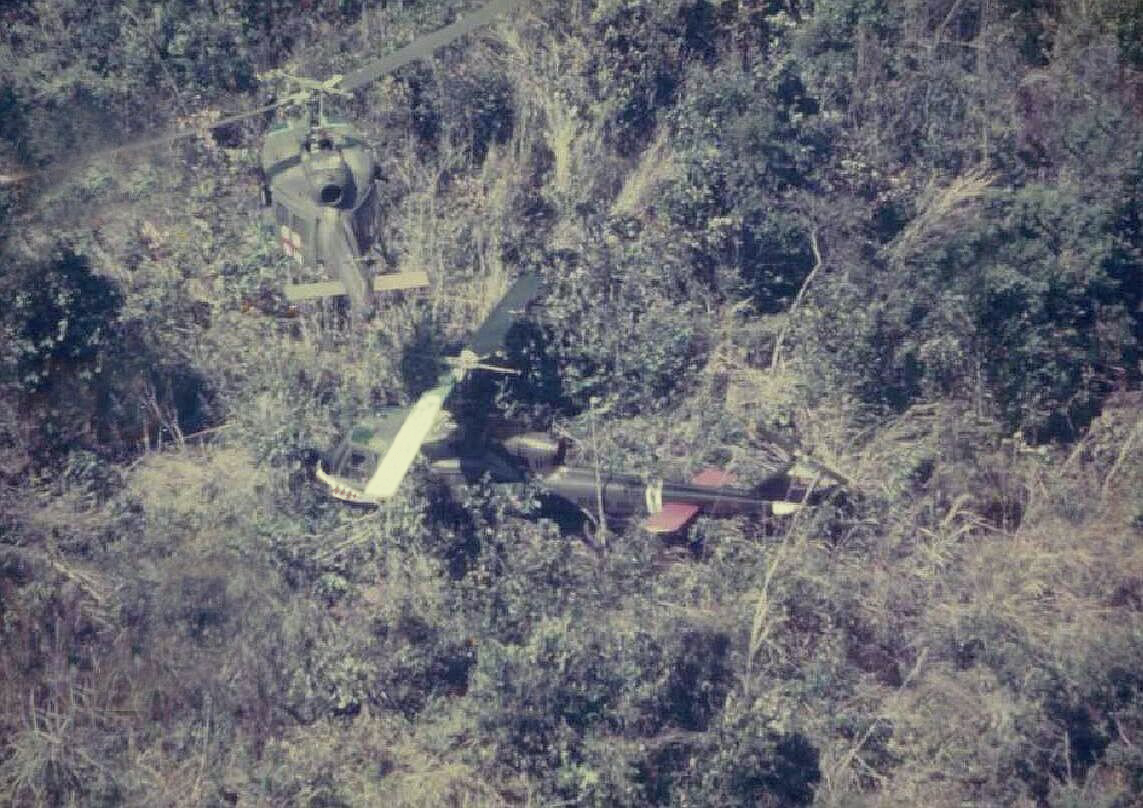
Shark 161, "Surfer," down in Laos with Howard "Mo" Modjeski in his DUSTOFF "Iron Butterfly" hovering over the Shark. Unable to land because of the bamboo, Mo's crew had to hoist them up. Photo nervously taken by Fred Thompson, 1971. |
Just as Fred's long count was about to end we came over a hill where the .51 calís that shot up Bruce were located. They were shooting away from us at Bruce and Fred when we first came over the hill. When they finally heard us they tried to
turn our way but just then we went by them. By the time they turned around
again to track us we were down range and tracers went by but we took no hits.
The Iron Butterfly protects those that fly her! Bruce went down in a little
valley of bamboo, east of the hill the .51 calís were. Fortunately there was a
small knoll between the gun emplacements and the ravine where Bruce landed.
This knoll prevented the .51 calís from a direct line of fire on Bruce.
I think air crews in general were exceptionally good at keeping their wits
about them under fire. But I think we all have to admit when a fellow airmen
went down, there was a extra effort and tension that developed that pushed us
all to the ragged edge, to rescue our downed brother. When we came upon
Bruce I can remember only wanting to land to extract him. I was very excited
and could not let a fellow airmen, let alone a flight school classmate, be
trapped on the ground hurt. I had lost one flight school classmate (John
Rauen) the night before and I was determine not to lose another one.
We had cut down trees with the main rotor on a Huey some six inches in diameter to
get into an LZ, but you could not cut any thickness of bamboo without tearing
the honeycomb out of the main rotor blades and creating an imbalance that
would destroy the aircraft. I was on my way in to land next to Bruce when
Basler called the bamboo. I can remember our Medic, Jeff Morris, coming on
the intercom and saying, "all right, everyone settle down!" Jeff could sense
we were all overly excited. With that we all settled down and coordinated
the process of hoisting Bruce and his crew out of the landing site in a very
business like fashion.
We came to a hover over the downed Charlie Model and started the hoist down for the first of three hoists. The downed crew came up 1-2-1 on the hoist. They sent Bruce up first. When I first saw him I thought he would surely lose his leg. He had taken a .51 caliber through the thigh and the leg had swollen up to more than twice its normal size.
Fred Thompson, Gary Harter, C/E Bill Wilder and their crew were the REAL HEROs that day. By the
time we had arrived, I had not realized they had made an attempt to extract
Bruce and his crew. Once over the downed aircraft our main rotor seemed just
high enough to be right in the line of fire from the .51 caliber position. The
green tracers looked like they were coming right through the rotor plane. I
asked for covering fire while we hoisted Bruce and his crew out of the LZ. I
did not know that Fred and Gary had punched off their rockets and Mini-guns
in order to try and land and reach Bruce before we had arrived on the scene.
Once we set to the task of hoisting out Bruce, Fred and Gary started flying
a harassment pattern to draw fire from the .51 cal positions. They only had
M-60 door guns! What a Hell of a Fake! They drew all the fire. Fred finally
called me about the third time we sent the hoist down and said, 'Mo, we're
out of ammo; we're going to start taking pictures, man!' Once we got
everyone in the aircraft we departed right behind Fred and Gary. I know
Gary thought we went high, but we were right behind him and we didn't think
he was low enough or fast enough all the way back to the border!"- Mo Modjeski,
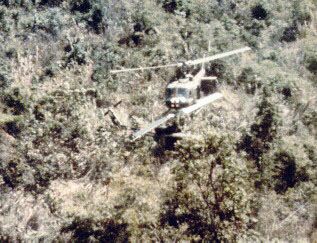
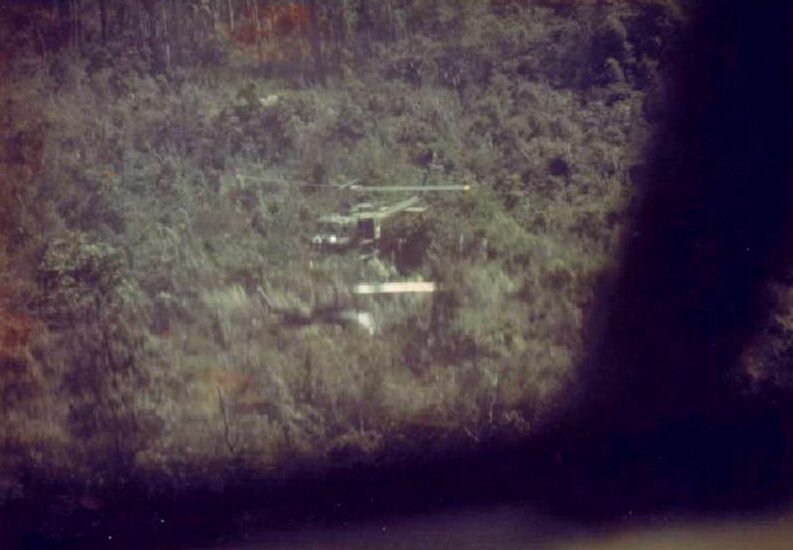
Shark 161, "Surfer," down in Laos with "Mo" Modjeski hovering over the Shark. This is a second picture taken by Fred Thompson as they hovered around the downed crew drawing the fire of the NVA .51 Cal anti-aircraft gun. Fred's Shark had blown off both its rocked pods with the explosive bolts (and pulled the door pins off ) earlier when they landed to attempt a rescue, and their minguns were hanging useless under the aircraft by their ammo chutes. Thompson's door gunners were out of ammunition by this time, so Fred shot with the only thing he had left; his camera. The bottom third photo, "I actually took this through the greenhouse window as we banked around."-Fred ( All Photos by Fred Thompson, 1971). |
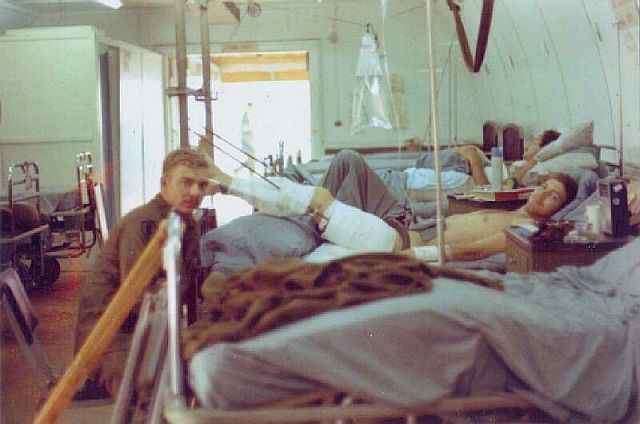
The photo above is Bruce Marshall in the Surgical Hospital Quang Tri, 24 Feb 1971 (The "visitor" on the left is Jim Souders)
